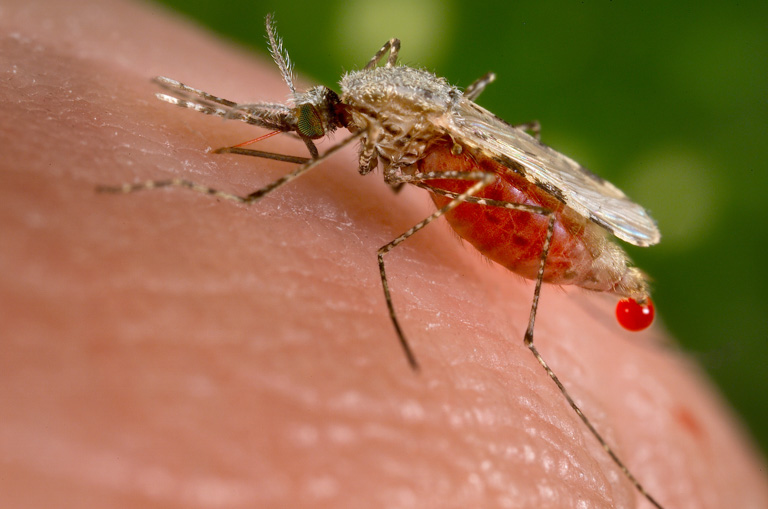- New research has found that malaria parasites need less time to develop at lower temperatures than previously thought.
- Earlier research postulated that malaria transmission in cooler areas was unlikely because parasites took longer to mature than the lifespans of their mosquito hosts.
- The researchers found that the parasites needed between 31 and 37 days to develop at 18 degrees Celsius (64 degrees Fahrenheit) — substantially lower than the 56 days postulated by previous research and well within the lifespan of female mosquitoes.
Climate change could shift the calculus for reining in malaria, according to new research that suggests that infectious parasites can develop in mosquitoes more quickly at lower temperatures than scientists once thought.
“Our study is the first since the 1930s to investigate the relationship between temperature and malaria parasite development,” Matthew Thomas, a professor of ecological entomology at Pennsylvania State University and one of the paper’s co-authors, said in a statement. That early research has guided scientists for decades, despite the fact that it rested on findings from a species of mosquito from Russia, which sits well outside the malaria-endemic tropics and subtropics.
“Our results challenge this long-standing model in malaria biology,” Thomas added.

Thomas and his colleagues, in a study published June 26 in the journal Biology Letters, focused their investigations on two species of mosquitos: Anopheles stephensi and Anopheles gambiae. A. stephensi and A. gambiae — actually a group, or “complex,” of nearly identical species — wreak havoc on human populations throughout their ranges in Asia and tropical Africa, passing along developed spores in their saliva.
The “long-standing model” holds that parasites need nearly two months to mature at temperatures of 18 degrees Celsius (64 degrees Fahrenheit). That’s butting right up against the lifespan of mosquitoes, making it unlikely that parasite-carrying mosquitoes will live long enough to slip the spores into a new host at this temperature — at least according to that old scenario.
Thomas’s team noted that the previous studies buttressing the trusted model had issues: Some didn’t have a control group to compare parasite development rates to those at a more balmy 27 degrees Celsius (81 degrees Fahrenheit). Or, they didn’t use Plasmodium falciparum, the parasite that causes the deadliest form of malaria.

So Thomas and his colleagues exposed groups of mosquitoes to a single temperature between 16 and 20 degrees Celsius (61 and 68 degrees Fahrenheit), along with a control group at 27 degrees Celsius, at which malaria transmission typically peaks. They also varied the temperatures for other experimental groups by 5 degrees Celsius (9 degrees Fahrenheit) in either direction, mimicking the range of temperatures that mosquitoes in the wild experience on a daily basis.
They found that the parasites needed between 31 and 37 days to develop at a constant 18 degrees Celsius — substantially lower than the 56 days postulated by previous research and well within the lifespan of female mosquitoes. (Hard-charging male mosquitoes often don’t last more than 10 days, and they don’t bite humans anyway.) When the temperatures varied between 18 and 23 degrees Celsius (64 and 73 degrees Fahrenheit), the time was even shorter at as few as 26 days.
“Our work shows that even small increases in temperature could dramatically increase malaria infections in humans because the parasites develop much faster at these lower temperatures than has been previously estimated,” Jessica Waite, the study’s lead author and an infectious disease biologist at Penn State, said in the statement.

Though it’s difficult to forecast just how climate change will alter places like the high-altitude plains of East Africa, this research demonstrates that bumping up highland temperatures could put millions of people around the world at risk of contracting malaria.
“As temperatures increase with climate change, infectious mosquitoes in areas surrounding mountains, for example, may be able to transmit the parasite higher up the mountains than they have in the past,” Waite said.
Banner image of A. stephensi mosquito by James D. Gathany/CDC via Wikimedia Commons (Public domain).
Citation:
Waite, J. L., Suh, E., Lynch, P. A., & Thomas, M. B. (2019). Exploring the lower thermal limits for development of the human malaria parasite, Plasmodium falciparum. Biology Letters, 15(6), 20190275. doi:10.1098/rsbl.2019.0275
FEEDBACK: Use this form to send a message to the author of this post. If you want to post a public comment, you can do that at the bottom of the page.
